
The Nomad is a series of stories, fascinations, encounters, observations, experiences, joy of the moments by me, Ulrike Reinhard – all around my travels. Stay tuned!
Ulrike Reinhard is The Nomad 🙂
I am in Namibia since two months and I deeply enjoy it. It is a beautiful country, it’s empty, its endless views, friendly and helpful people are just a bliss. I had read that public transport doesn’t exist – and that it would be difficult to go around without a car. People told me, you’ll never reach where you want to go. Well, I thought, let’s go with the flow and see.
“Going local” in Namibia – Episode 2
When I arrived in Namibia at Keetmanshoop, I had time to “study” the Namibian local transport system first hand. I learned that it is important
- where the local taxi / bus starts
- where you sit
- when you are planning to leave
You find the same thing in many countries in South America, Asia and in the Middle East. The system is designed that the car is only leaving when it’s full. This can take quite some time. And very often the drivers are exhausted by the time they leave because getting the customers takes plenty of phone calls and it costs them money when someone else is bringing a customer in. They expect a tipp. The sharply calculated prices give the driver profit only when all or most of the seats are sold. Sometimes they also transport parcels and other goods, even mail. This adds to their income. When you are the first to come to get a good seat, preferrably the one in the front, but you might end up waiting for quite a while until the taxi is leaving. This can be a couple of hours …. No one seems to be bothered about this endless waiting times – except me. Time is something people in Africa – just like in India – seem to have in abundance. Once the taxi is on the road it also picks up people on the way. Every now and then people would stand at the road side waiting for a ride.
If you are lucky – and this only holds true for frequently travelled routes – the taxis are filling up quickly or they are already fully booked by the time they start. The drivers will pick you up from your location and at the other end they will drop you where you want to be dropped. For example Swakopmund – Windhoek is such a route.
The less frequently traveled routes were my chance 🙂
Over the weeks I designed my own transport system in Namibia which would bring me where ever I wanted to go. It had these local taxis at its core and bypassed the horrendous rates some lodges and hotels were offering to get you from A to B. And on top of it, it helped some locals to travel easier and cheaper. A win-win-situation for everyone. Even though I was using these local taxis / buses before in other countries, it never occured to me to use it in this way 🙂
The first time I put it in practice was from Sesfontein to Opuwo, a distance of 220 km in northern Namibia. Sesfontein is a small village (7000 people) in the northeast of Namibia. Some tourists drive through or stop on their way to Purros and Marienflusstal, it is rather a less frequently visited place, still somehow untouched. A beautiful valley suffering from drought, the last heavy rains were seven years back. The Germans had built a “fort” there in 1896 – it is re-established in its old structure and now serves as a hotel owned by a German.
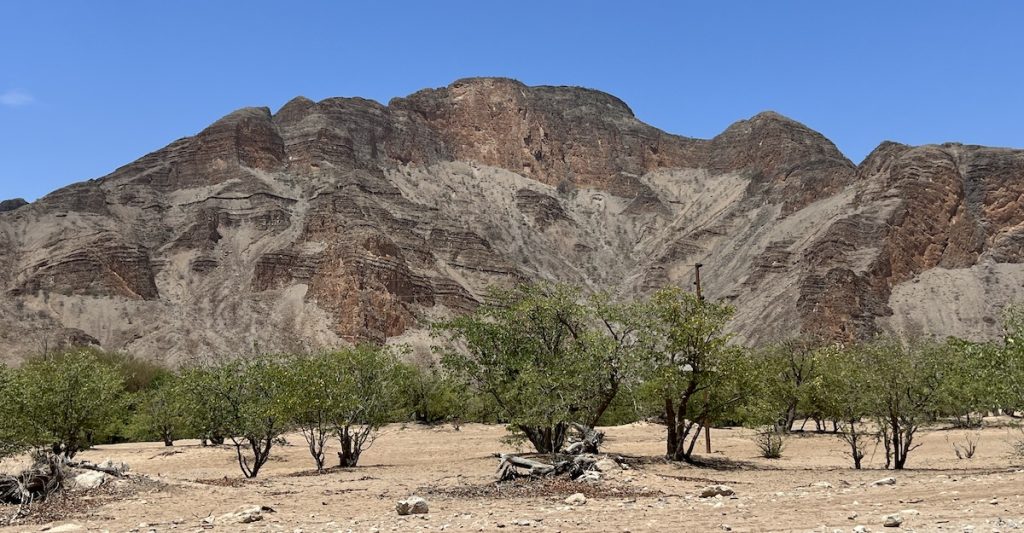
Sesfontein Valley
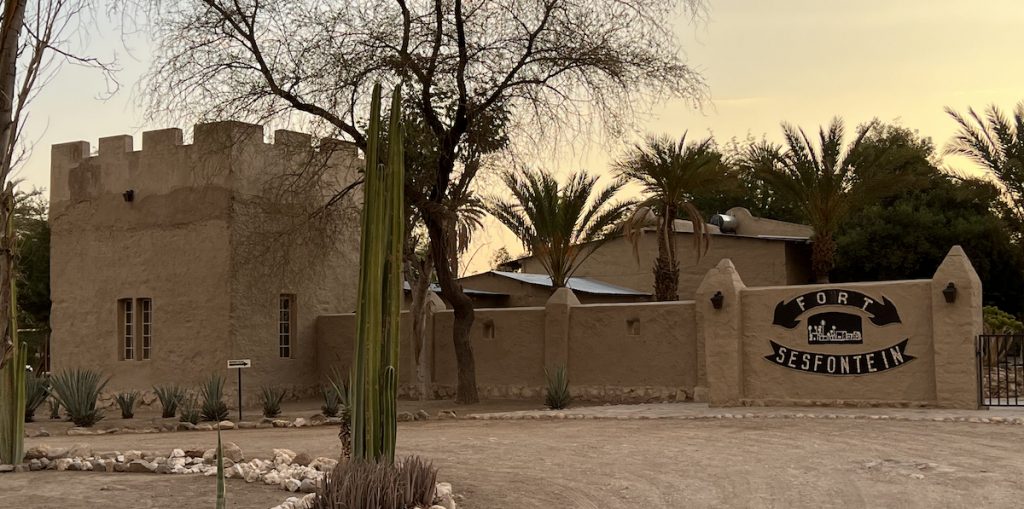
I was actually very much surprised to find a local taxi service between these two locations. A lady at the petrol pump had given me Scalla’s phone number when I was asking around. Sacalla lived a bit outside of the village and he drives every day this route. In the morning from Sesfontein to Opuwo, and later in the afternoon back. He must have done this road a thousand times. Especially in the beginning of the month many people travel, they receive their payments from government or companies and they go shopping and spend their money in town. This is the best time for Scalla. I called Scalla and he said he would come and pick me up next morning at 7.30am at the hotel. Surprisingly he was very much on time.
In his pick-up truck, which is in pretty good conditions, he usually loads 4 people in the cabin (one in the front passenger seat, three in the back row) and another six in the loading area in the back where they also load the luggage, the “open air seats”. 10 in total. The fare is 150 Namibian Dollars (NAD), approx. 8 Euros) per person. The total one way income is 1500 NAD plus the goods he is transporting minus the petrol. Scaffa makes probably 1000 NAD per route if the car is full.
We drove from the hotel to the center of the village where already two Herero ladies were waiting. One was holding a little baby in her arms. Hereros are one of the tribes living in this area – their ladies always wear beautiful hats.
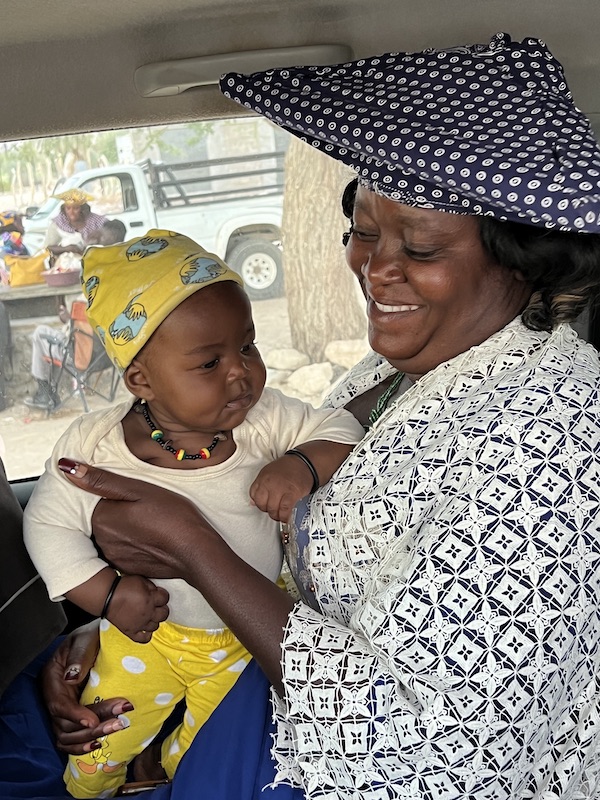
A Herero lady with her grandchild.
Now was the moment to explain Scalla my idea of transport.
I said: “Scalla, we don’t wait any longer. We go. I will pay for the not-to-be-here-passengers and we leave!” So my “fare” would be 1500 NAD (= full capacity) – 300 NAD from the two Herero ladies = 1200 NAD for me. This was 20% of what the hotel would have charged me for the same distance. Scalla was baffled. He couldn’t believe what he was hearing and propbably thought I was nuts.
He hesitated a short moment and then he said: “Yes, we leave! It is the same business for me!” So he got the point and we were on the road. Lucky me.
While we were driving I told him to stop whenever we see elder people or ladies with a child on our way. I asked him to pick them up and give them a free ride. Again, he looked surprised. After we had taken the first passenger on board, an older lady with a small child, he said: “This is very nice of you to give these people a free ride. Usually when I pass by, my car is already full and it gets very uncomfortable for them. Sometimes I even can’t stop because I am already overloaded. This way they have a fair chance to get a ride!”. I nodded and smiled. A few minutes later we picked up an elder man from a very simple house in the middle of nowhere. Besides a gas tank and various bags he carried a chicken along. It was still alive, packed in a back. He joined the lady with the child on the back of the pick-up truck. They looked happy.
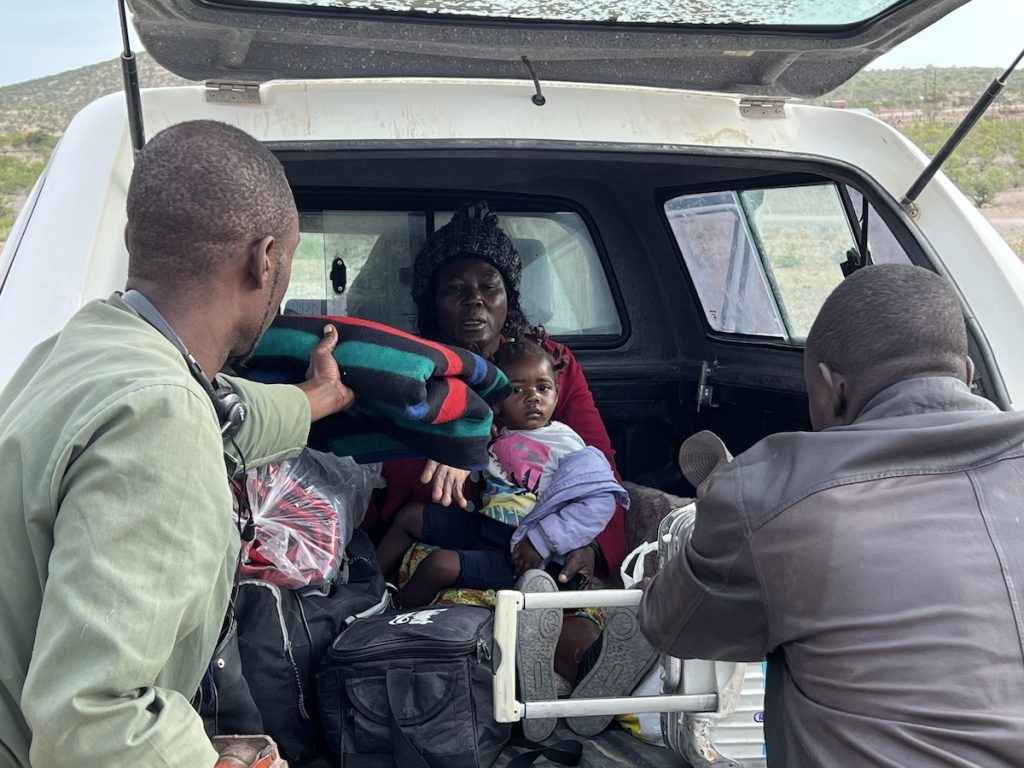
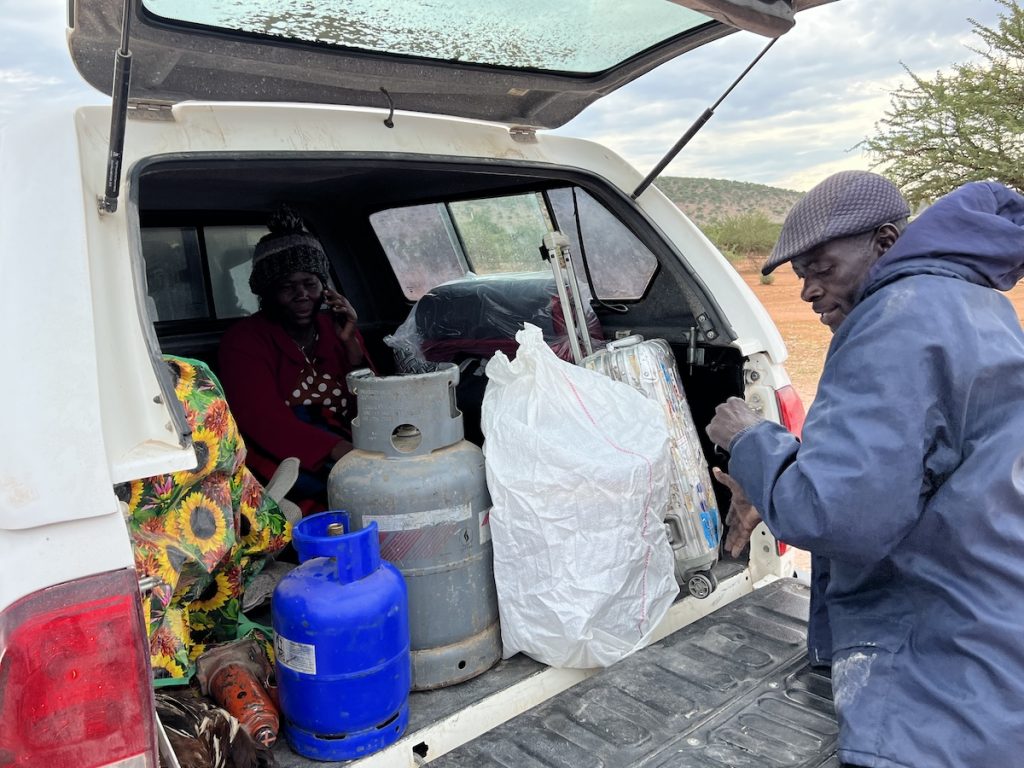
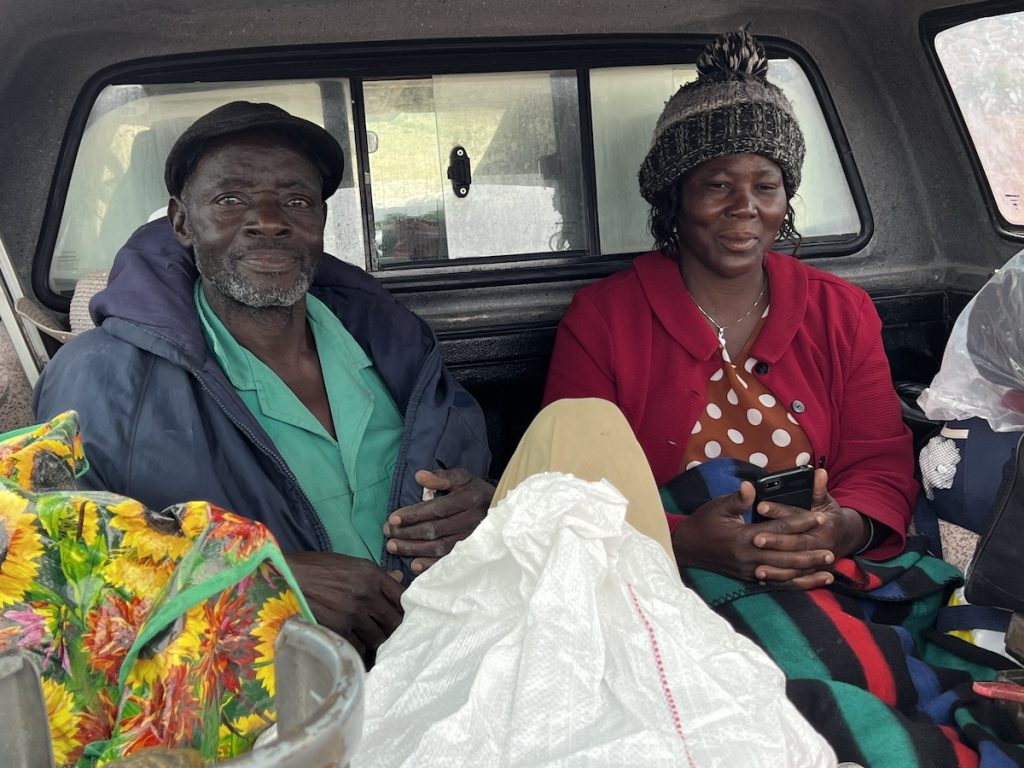
Passengers we picked up on our way
Both passenegers went all the way to Opuwo with us and were very pleased at the end that they don’t had to pay a fare. We’ve made their day! And Scalla, the driver, was also happy. At some point he told me, that he could make some extra money if he would take a fare from them, but he understood, that it wasn’t about him to make extra money – he was fully paid from my side – but it was about me getting an easy and cheap ride (pick up at the place where I stay, front seat and leaving on time) and helping people on the way. He got it!
The idea and my system seem to work.
On my next trip from Opuwo to Epupa Falls (220 km) I practiced the same thing. Lex and his companion picked me up at the hotel almost on time, they were 10 minutes late, we filled up the petrol in town – he obviously needed my money to do so, and then we started pur journey into the Himba land. The Himba are indigenous people with an estimated population of about 50,000 people in Namibia. They are semi nomads and prefer to live in their traditional way which is at times quite confusing for them and also others in society. I stayed with them for a week and I will write about it in a seperate bogpost.
Lex and his companion were quite different from Scalla. It was so obvious all what counted for them was money. Young hip men in business. Lex is a Himba as well – he opted for a “normal” life and left his tribe to live in Opuwo. He said he went to school until 12th grade – I had my doubts.
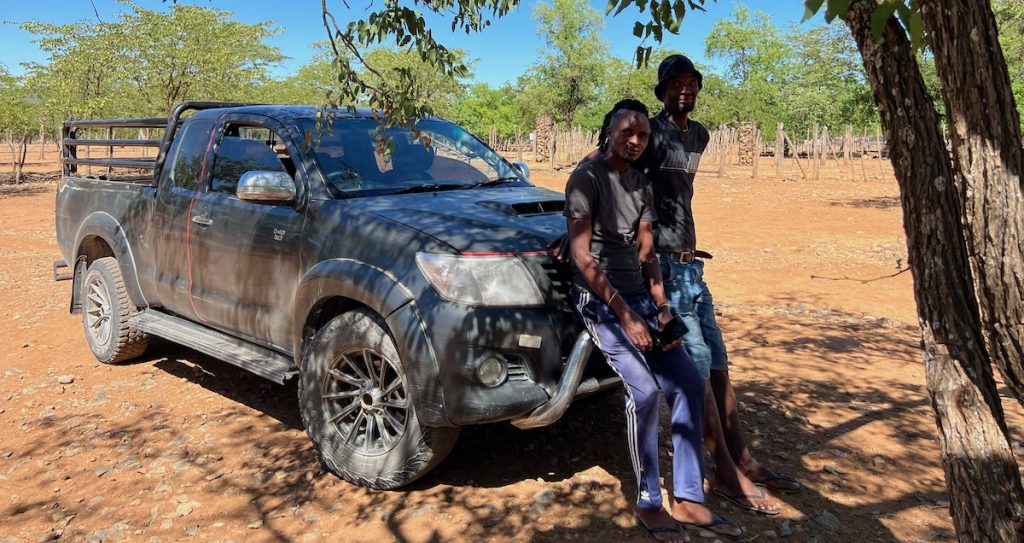
Lex (left) and his companion
The conversation mainly circled around how Lex could help me to go around in Namibia and him making money out of this; he even offered me to become my boyfriend if I would take care of him 🙂 I happily rejected his offer!
The road to Epupa Falls is pretty bad. We crossed multiple dry river beds, even though it was rainy season. The region didn’t have much rain for the last 10 years!
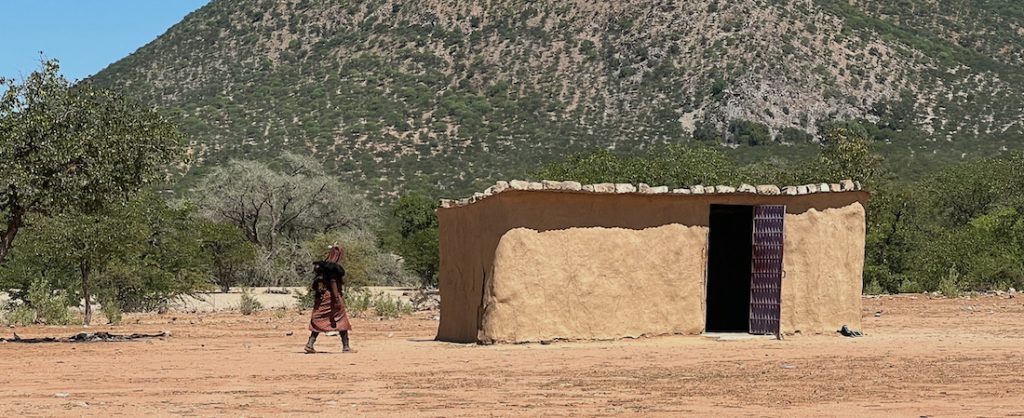
A single mud house along the way
The area is sparsely populated. It took us a while to find the first passengers. My two guys were very resistent to take them on. It was an old man whose thighs were severely swollen. He was accompanied by two younger man who had to prop him up. They were traditional Himba and looking for a lift to Okangwati, the next bigger settlement, where a hospital is. Reluctantly Lex agreed to get them on board. And of course he wanted to charge them.
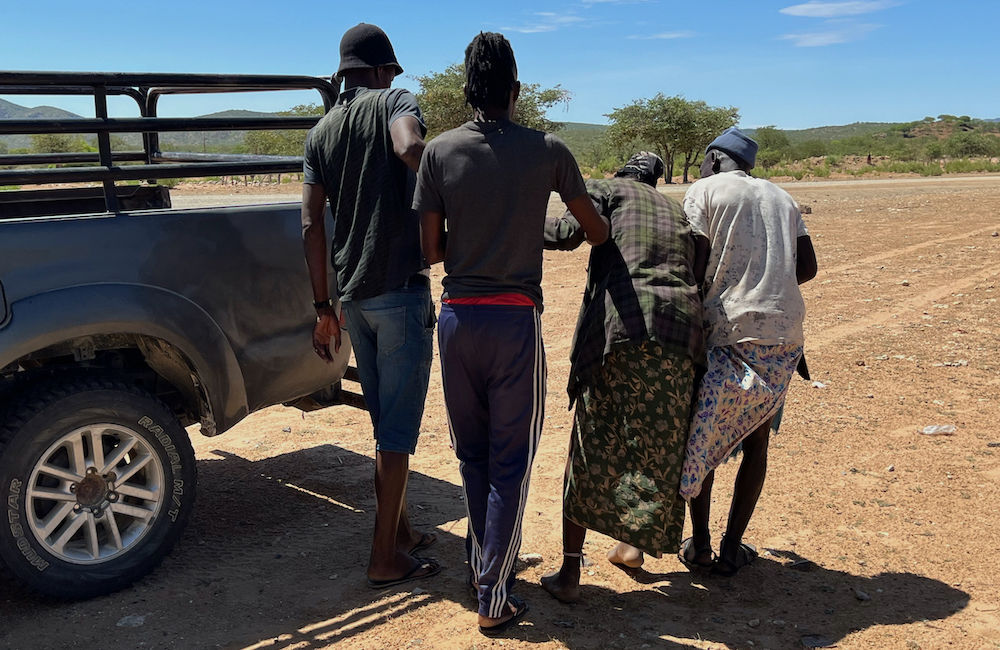
I said: “I’ve paid for them, no need to get money from these people who hardly have anything!” Lex was surprised. “Why?” he said, “they are getting a lift!” So I explained him that I had paid the fare for the entire pick up and that he had all the money. “So we don’t take additional people”, he replied. “Why do I need to stop and take extra people?” “You would do it normally on your way as well, right?” I asked him. He agreed. “So what’s the point?” I wanted to know. “We are just doing the same thing. Just imagine this would be someone from your family, you would be happy if they’d received help, wouldn’t you?” This worked.
We stopped at Okangwati in front of the hospital. Then they said, they only go to the hospital tomorrow and we should drop them 1 km down the road. They’d changed their mind – I felt like I was in India: they think one thing, say another and do a third. I wasn’t really surprised. We moved on and dropped them where they wanted.
Okungwati is a shappy small town, yet lively. Himba and Ovathemba line the dusty roads. All in their traditonal clothes. There was no hurry, all was very much relaxed. Some bars and shops with hardly any products. We stopped at Alfons Restaurant, a place well-known for its freshly baked bread. A friend had told me of it. I bought six buns for 60 Eurocents, shared them with my two guys. They were still warm and tasted deliciously. In front of Alfons we collected more passengers; Himba ladies who had received their maize flour from government and now wanted to go back home. Where ever home was at the current stage. We loaded everything and off we went.
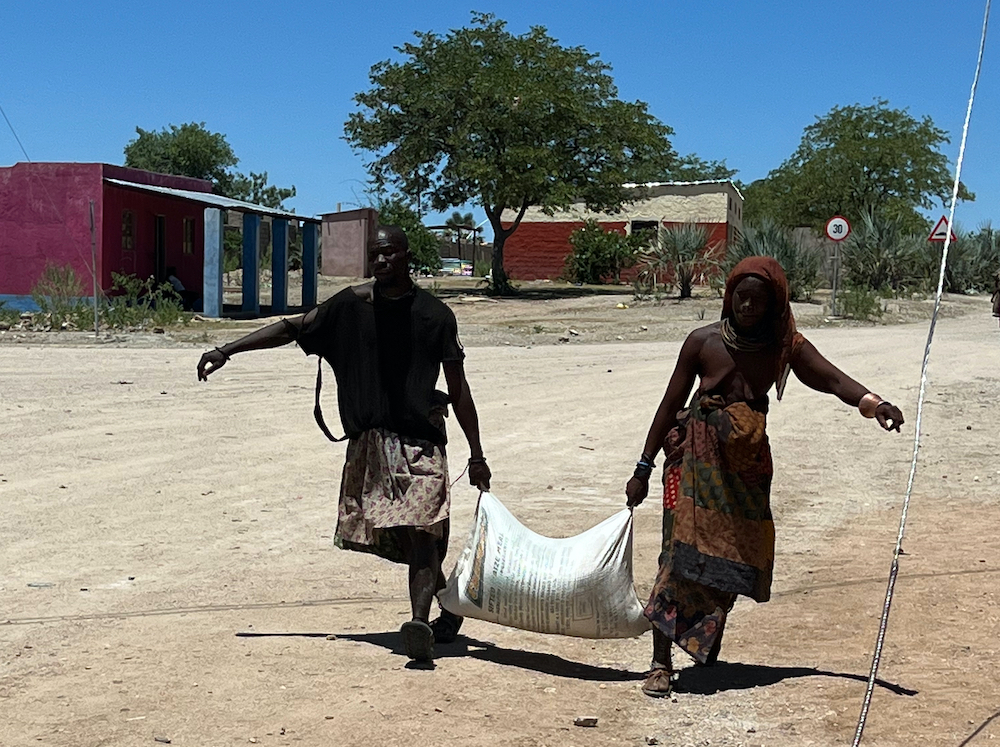
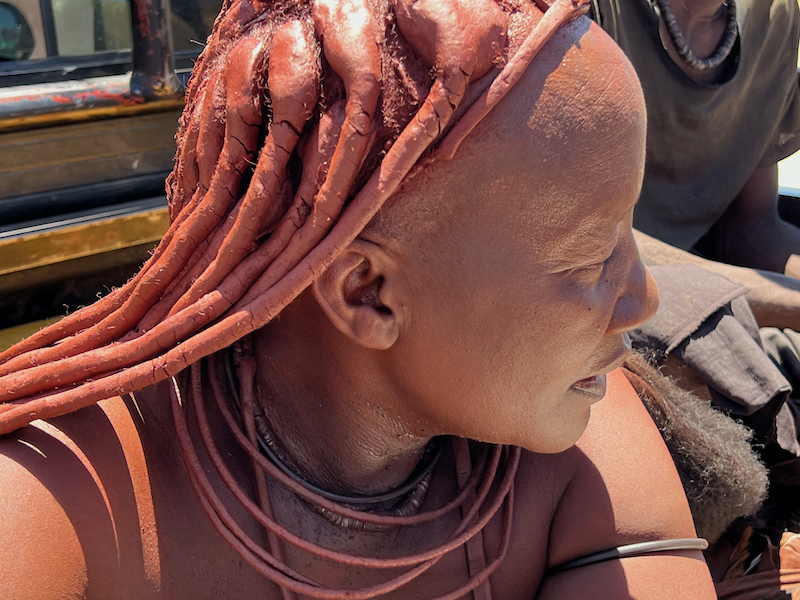
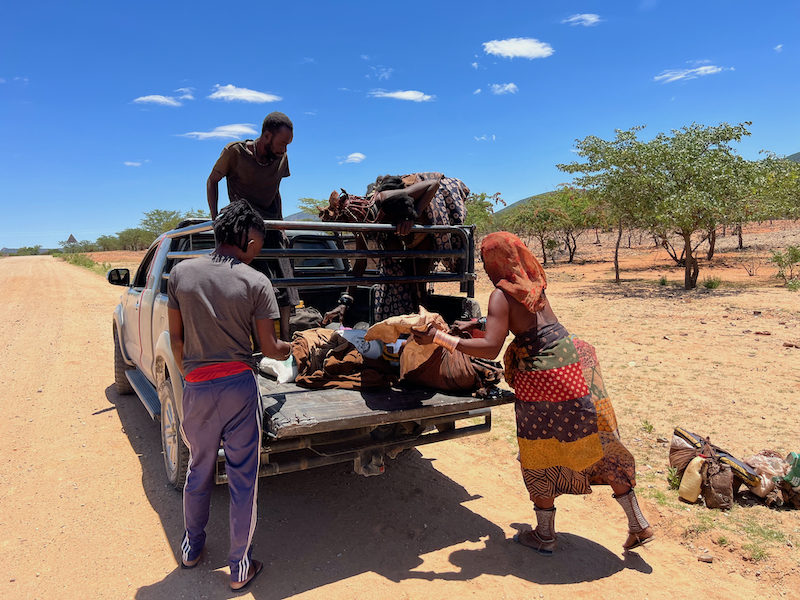
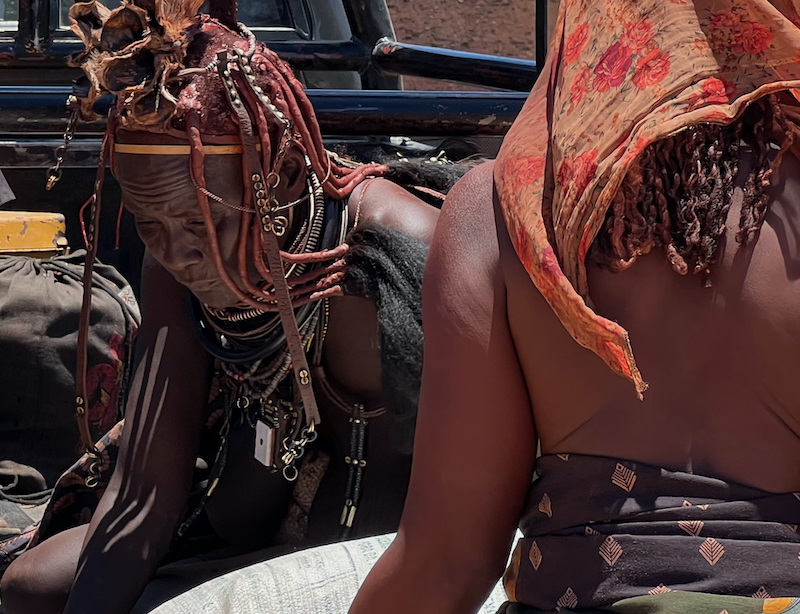
This time Lex understood and didn’t ask for money, nevertheless he complained why we would take “these” people; people of his own tribe. He felt ashamed that they live like they do and argued that they should give up their traditions and accept “modern” life. Modern life in his world would mean living in a shack without water and electricity in some smaller city. One wonders what is better. I left it with that.
At Epupa Falls, Lex dropped me at my hotel and after a last attempt to become my “boyfriend”, he left. Once again my system had worked and created a win-win-situation for everyone involved. I stuck with it on my way forward. It was quite fun for me and brought me a bit closer to better understand the people in the country. I didn’t encounter any “dangerous” or risky situation – in contrary all the people were kind, firendly and as curious as myself.